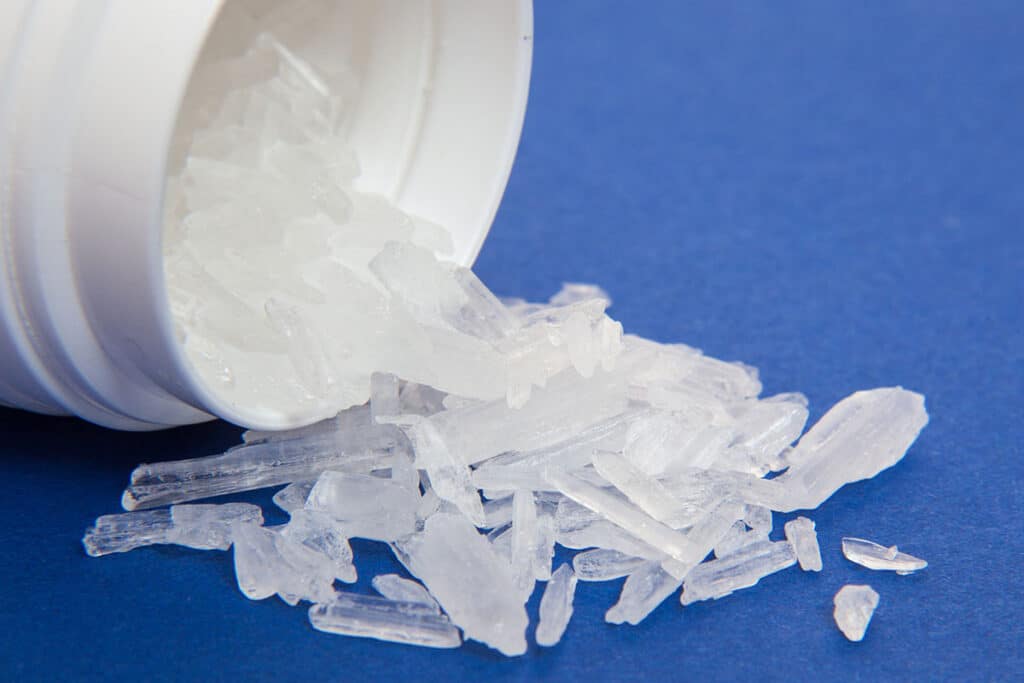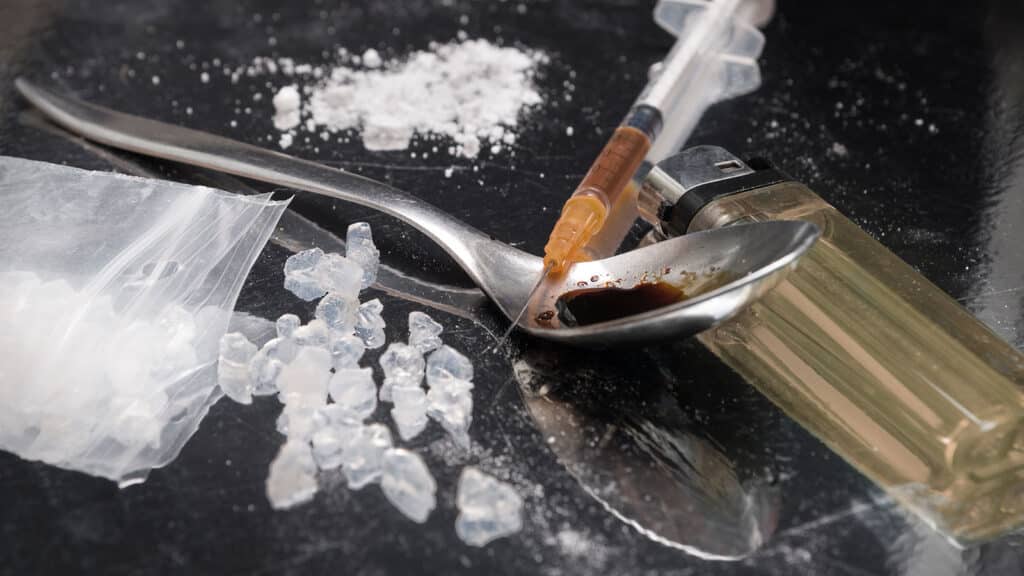With over half a million meth users per week in the U.S., identifying the drug can prove critical. One of the ways you can recognize meth is through its unmistakable taste and smell.
Meth primarily tastes bitter and tart. Nevertheless, its taste differs based on its source. Some batches have different levels of ingredients. For instance, ones with more sulfur-infused ingredients will likely carry a rotten egg taste.
Meanwhile, if it has more gasoline or combustible ingredients, it’ll have a more distinct alcoholic taste.
In most scenarios, meth tastes like it smells, which can range from ammonia to burning plastic. That said, stick around to learn more about meth’s smell.

Table of Contents
Meth Taste
Meth typically has a bitter taste. In most cases, it tastes the same as it smells. The drug often smells of rotten eggs, metal, burnt plastic, and vinegar. It has a distinctively chemical taste, whether the narcotic is crystal, powder, or liquid.
In other cases, flavored meth offers users a more flavorful taste. Drug producers may add strawberry, orange, cola, or chocolate flavors to appeal to a larger audience. They also name the product based on its flavor. For instance, drug dealers may sell strawberry-flavored batches as pink meth.
Flavored meth is also termed “Yaba,” This form of meth contains meth, caffeine, and added flavors and comes in pills.
That said, first-time users of meth may experience nausea from the overwhelmingly acidic and unappealing taste.
What Affects Meth Taste?
As a synthetic drug, meth has multiple origins and blends. For this reason, it may not always taste the same. The levels of ingredients added affect the taste of the drug. These ingredients can include:
- Cleaning Products
- Paint Thinner
- Hydrogen Peroxide
- Lithium Battery Acid
- Acetone
- Iodine
- Solvents
- Ephedrine
- Anhydrous Ammonia
- Chlorine
- Freon
- Chloroform
- Gasoline
- Camp Stove Fuel
- Sulphuric Acid
- Epson Salt
- Propane
- Lye
The primary flavor in meth is the over-the-counter medicine known as pseudoephedrine. The medication gives meth its bitter taste.
Drug distributors and manufacturers term the process of making the drug “cooking meth” because it involves heat. Once the ingredients infuse together, they create an odorous product with a pungent taste.
Meth Taste Based on Type
There are two types of meth sold, prescription and illegal. Both carry distinguished tastes due to their ingredients’ concentration.
Illegal Meth Taste
Illegally sourced meth usually comes in a white or light brown powdery form. With the variety of dangerous ingredients added, it can taste different each time. If the drug contains more ammonia, it can taste like cat urine.
Drug manufacturers also use cutting agents to bulk their products. They can include milk powder, talc, and sugar, which can influence the taste of the drug. Since meth has such an unpleasant taste, most users opt to snort, inject, or smoke the substance.
Prescription Meth Taste
Although meth is synonymous with abuse, the narcotic also comes in an FDA-approved pill prescription form. Medical professionals label the drug methamphetamine hydrochloride or Desoxyn.
The medication treats patients suffering from Attention Deficit Hyperactive Disorder (ADHD), narcolepsy, and obesity. Users describe the pill as tasteless, while others can taste some bitterness.

Dangers and Risks of Ingesting Meth
Meth poses several risks to human health, both psychologically and physically. Although multiple users take meth through various paraphernalia, the drug is also popularly ingested. After knowing what the narcotic tastes like, here are the effects of ingesting meth.
Psychological Effects of Meth
Meth primarily targets your brain’s dopamine levels. It causes a temporary increase in the happy hormone bringing about euphoria and alertness. Nevertheless, ingesting meth doesn’t produce an instant rush associated with smoking and injecting it.
Instead, the effects of meth, when ingested, appear after 15 to 20 minutes. Meanwhile, snorting meth can produce the euphoric effects after only three to five minutes of intake.
Neurological Damage
Meth triggers the brain’s dopamine production. Constant use of the drug can hinder this production from naturally occurring. Consequently, meth can result in anxiety, paranoia, hallucination, and paranoia.
Cognitive Issues
Meth can also inhibit proper cognitive function, such as recalling information. The drug causes neuronal death in the hippocampus, which is responsible for memory and learning.
Neuronal death occurs when the number of neurons in the brain’s Central Nervous System (CNS) decreases significantly. In most cases, the cells’ recovery is unlikely.
Physical Effects of Meth
Not only does the drug affect brain function, but your body’s system as well. The intense psychological effects of meth induce increased blood pressure and heart rate. Here are other physical risks associated with meth intake.
Stomach Issues
Ingesting meth can pose multiple risks to your gastrointestinal health. That said, the drug induces dopamine production. The hormone’s presence can alter your ileum’s, or the last part of the intestine, ability to contract.
In turn, the waste in your intestine can’t move out of your body, and you can experience constipation. In addition, since meth constricts your blood flow, it can reduce the blood supply to your vital organs like the gallbladder and intestines. Consequently, the body will likely experience organ failure and critical ulcerations.
Meth Mouth
Ingesting meth can lead to increased oral health risks. Your mouth naturally produces saliva to protect your teeth. Abusing meth can reduce your salivary glands’ ability to make the fluid protectant leaving you with a dry mouth.
The added ingredients tend to be acidic. They can include battery acid, cleaning agents, and fertilizer, which can deteriorate your enamel. Additionally, since the drug causes excess paranoia, users grind their teeth excessively, which wears their teeth.

Meth Side Effects
Methamphetamine, a potent stimulant drug, carries a range of severe short-term and long-term side effects stemming from meth use and meth abuse. Whether it’s crystal meth, powdered meth, or in pill form, the effects are devastating. Smoking meth or using glass pipes delivers the drug quickly to the brain, intensifying these effects.
Short-Term Side Effects of Meth Use:
- Intense Euphoria: Methamphetamine use causes a rush of dopamine, leading to a powerful feeling of pleasure. This is a primary driver of meth addiction.
- Increased Energy and Alertness: Users experience a surge of energy, decreased fatigue, and heightened alertness.
- Decreased Appetite: Meth acts as an appetite suppressant, often leading to significant weight loss.
- Increased Body Temperature and Heart Rate: Meth use elevates body temperature and heart rate, potentially leading to dangerous hyperthermia and cardiovascular problems.
- Mental Health Effects: Even short-term meth use can trigger anxiety, paranoia, irritability, and insomnia. Psychosis, including hallucinations and delusions, can also occur, even with short-term use.
Long-Term Side Effects of Meth Abuse and Meth Addiction:
- Severe Addiction: Meth is highly addictive, and meth addiction is a serious and chronic substance use disorder. Cravings for the drug can be intense, making it extremely difficult to quit.
- Brain Damage: Long-term meth abuse can cause significant brain damage, affecting cognitive function, memory, and motor skills.
- Psychosis and Mental Health Issues: Prolonged meth use significantly increases the risk of developing or worsening mental health problems, including psychosis, depression, and anxiety. These effects can persist even after ceasing meth use.
- Cardiovascular Problems: Chronic meth abuse damages the cardiovascular system, increasing the risk of heart attack, stroke, and high blood pressure.
- Physical Deterioration: Meth abuse can lead to severe weight loss, dental problems (“meth mouth”), and skin sores.
- Social and Occupational Problems: Meth addiction often leads to job loss, relationship breakdowns, and financial difficulties.
Meth ingredients used in meth production, often in illegal meth labs, are highly toxic. Exposure to these chemicals poses significant health risks, even without direct meth use. Law enforcement agencies are constantly working to shut down these dangerous operations.
Meth addiction treatment is crucial for those struggling with this devastating substance use disorder. Providers offer various treatment options, including behavioral therapies and, in some cases, medication. Overcoming meth addiction is a challenging process but is possible with professional help.

To Conclude
To conclude, meth often has a bitter taste and pungent odor, though the specific taste can vary depending on the ingredients. Meth with more alcohol-based ingredients tends to taste chemical and bitter, while sulfuric additives can impart a rotten egg aroma and taste. Regardless of the specific taste, meth use has detrimental effects on both physical and psychological health, ranging from neurological issues to dental problems. If you or a loved one is struggling with meth addiction, effective treatment options are available.
Contact Garden State Treatment Center for help. They offer various addiction treatment programs, including both inpatient and outpatient care, and utilize evidence-based approaches like behavioral therapy to support recovery.
Published on: 2023-02-27
Updated on: 2025-02-20



